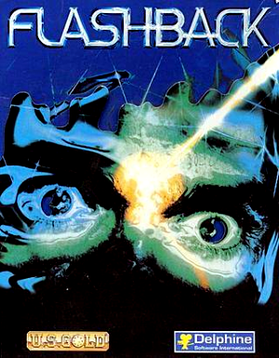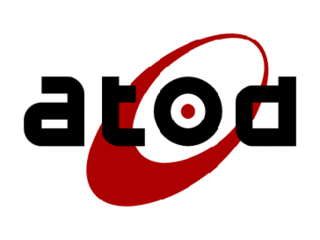
The 3DO Interactive Multiplayer, also referred to as simply 3DO, is a home video game console developed by The 3DO Company. Conceived by entrepreneur and Electronic Arts founder Trip Hawkins, the 3DO was not a console manufactured by the company itself, but a set of specifications, originally designed by Dave Needle and RJ Mical of New Technologies Group, that could be licensed by third parties. Panasonic produced the first models in 1993, and further renditions of the hardware were released afterwards by GoldStar, Sanyo, Creative Labs, and Samsung Electronics in 1997.
Rage Games was a British video game developer. Formed in Liverpool in 1992, its video games were marked by an emphasis on graphical effects with arcade gameplay.

Soccer Kid is a 1993 side-scrolling platform game developed and published by Krisalis Software in Europe for the Amiga. The player assumes the role of the titular main protagonist who travels across several countries around the world to repair the World Cup by retrieving pieces that were scattered by the alien pirate Scab, the main antagonist who failed to steal and add it to his trophy collection in a robbery attempt. Its gameplay mainly consists of platforming and exploration elements, with a main single-button or two-button configuration, depending on the controls setup.

Flashback, released as Flashback: The Quest for Identity in the United States, is a 1992 science fiction cinematic platform game developed by Delphine Software of France and published by U.S. Gold in the United States and Europe, and Sunsoft in Japan.

Primal Rage is a fighting game developed and released by Atari Games to arcades in 1994. The game takes place on a post-apocalyptic version of Earth called "Urth". Players control one of seven large beasts that battle each other to determine the planet's fate. Matches feature many of the conventions of fighting games from the era, including special moves and gory finishing maneuvers. Ports were released for home consoles and personal computers. Efforts to perfectly emulate the arcade original have been unsuccessful due to the use of an unusual copy protection method. Toys, comics, a novel and other merchandise tie-ins were produced. More than 1.5 million copies of the game were sold.
1992 saw many sequels and prequels in video games, such as Dragon Quest V, Final Fantasy V, Sonic the Hedgehog 2, Street Fighter II: Champion Edition, Super Mario Land 2: 6 Golden Coins, and Super Mario Kart, along with new titles such as Art of Fighting, Lethal Enforcers, Mortal Kombat and Virtua Racing.

Turrican is a 1990 video game developed by Manfred Trenz. It was developed for the Commodore 64 by Rainbow Arts, and was ported to other systems later. In addition to concept design and character creation, Trenz programmed Turrican on the Commodore 64. A sequel, Turrican II: The Final Fight, followed in 1991 for the Commodore 64 and other platforms.

Ultimate Soccer is a 1993 soccer video game by Rage Software released for the Mega Drive/Genesis, Master System and Game Gear by request of Sega which even allowed their mascot, Sonic, to be featured in the game menus. While similar in name, it has no relations with the Ultimate Soccer Manager series, but was followed by Striker still for the Mega Drive/Genesis, Striker '96, released for MS-DOS, Sega Saturn, and PlayStation, and Striker Pro 2000, released for PlayStation and the Dreamcast. While never published to the Super Nintendo Entertainment System, Rage developed other games for the Nintendo console, including Elite Soccer, Manchester United Championship Soccer and World Soccer 94 – Road to Glory.
Appaloosa Interactive was a corporation, founded in 1982 in Hungary, that produced video games, computer programs and television commercials during the 1980s and 1990s.

FIFA International Soccer is a 1993 association football video game developed by EA Canada's Extended Play Productions team and published by Electronic Arts. The game was released for the Sega Mega Drive/Genesis console in December 1993 and ported to numerous other systems in 1994. It is the first game in the FIFA series.

California Games II is a sports video game released by Epyx for MS-DOS in 1990. Versions were published for the Amiga, Atari ST, and Super Nintendo Entertainment System in 1992, then the Master System in 1993. This game is a sequel to California Games. An Atari Lynx version was announced and previewed in several magazines but was never released.

There have been several video games based on the 1991 film Hook. A side-scrolling platform game for the Nintendo Entertainment System (NES) and Game Boy was released in the United States in February 1992. Subsequent side-scrolling platform games were released for the Commodore 64 and the Super Nintendo Entertainment System (SNES), and an arcade beat ‘em up by Irem later in 1992, followed by versions for the Sega CD, Sega Genesis, and Sega's handheld Game Gear console in 1993.

Atod AB/LG Software AB was a video game developer located in Helsingborg, Sweden.
Barry Leitch is a Scottish video game music composer, responsible for the music in many games spanning multiple consoles and personal computers. Most notable is his work from the Lotus Turbo Challenge, TFX, Gauntlet Legends, Gauntlet Dark Legacy, Top Gear, and Rush video game series.

Baldies is a 1995 real-time strategy video game developed by Creative Edge Software and originally published by Atari Corporation for the Atari Jaguar CD. It was later ported to the PC, PlayStation, and Sega Saturn. In the game, the player manages a community of Baldies in order to build structures, increase their population, and create weapons to fight against enemies known as Hairies. There are four classes of Baldies and each structure has specific properties to assist the player. Its gameplay combines strategy with simulation and god game elements. Up to four players can participate in a multiplayer mode via local area network (LAN) on PC.
Tiertex Design Studios Limited was a British software development company and former video game developer based in Macclesfield, England; it was founded in 1986, focusing on porting games to home computers and handheld platforms.

Goal! Two is a soccer (football) video game developed by Tose for the Nintendo Entertainment System (NES), and published by Jaleco in 1992. Goal! Two is Tose's first sequel to the NES title Goal!. On 04/24/92, Tose's first soccer title for the Super Famicom, Super Cup Soccer (スーパーカップサッカー) was published by Jaleco. It was later ported to the Famicom on 09/25/92 as Goal!!. Jaleco localized the Famicom game for the NES as Goal! Two for North American markets, and Goal! 2 for European markets later that year. Finally, the Super Famicom version was brought to the Super NES (SNES) as Goal! for North America and Super Goal! for Europe in December 1992, shortly after Goal Two! for the NES. The cover model is John Brady, an amateur soccer player from London who was living in Chicago.

Casual Arts, formerly known as Flair Software, is a British video game developer and publisher of the 1990s that developed and published games for the Amiga, Amiga CD32, Atari ST, Commodore 64, DOS, PlayStation, Sega Saturn and SNES. It was set up by Colin Courtney in 1990 after his previous company, Tynesoft, went bankrupt. It retained Tynesoft's MicroValue brand and published Elvira: The Arcade Game which had originally been scheduled for publication by Tynesoft.













